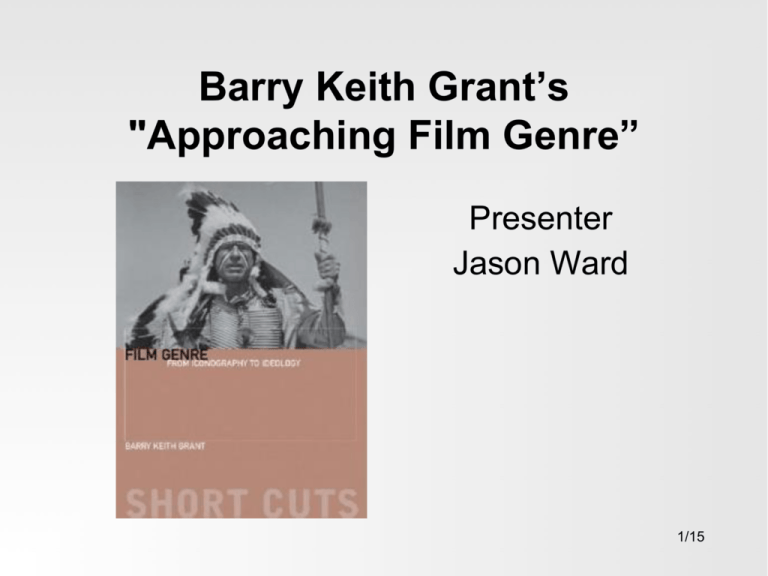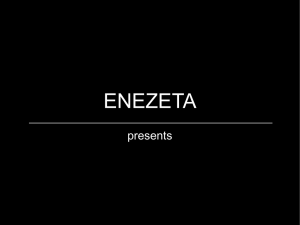Teacher's Demonstration of PowerPoint Presentation
advertisement

Barry Keith Grant’s "Approaching Film Genre” Presenter Jason Ward 1/15 A 300-word Summary 1/5 • Approaching Film Genre states that genre criticism did not start with film but rather Aristotle’s distinction between comedy and tragedy. Grant describes how genre films are criticized for being lowbrow, formulaic, massproduced, conservative and oppressive, but also express the spirit of the age and can be read as representing sites of ideological struggle. He describes the evolution of film genres as part of the Hollywood industrial system, which sought to maximize profits for minimum risk. 2/15 A 300-word Summary 2/4 • This production line process lead to repeated character traits, story lines, setting, objects and props that could be used interchangeably like machine parts. From the beginning, certain types of films were grouped together by producers and audiences. Because of the systematic and collective way in which it was produced, film emerged as a truly communal art form. 3/15 A 300-word Summary 3/5 • The setting, stories, themes, and even the believability of a film are all determined by genre, as are its iconography. Icons are described as objects or characters within films which gain meanings from their repeated use across many different films. Grant explores the significance of iconography to express meaning within the film and across different cultures. 4/15 A 300-word Summary 4/5 • Through iconic casting genre films give the audience what they expect by casting an actor renowned for playing good guys as a hero or can subvert this expectation by having him/her play against type as a villain. A film’s iconography might also extend to a genre film’s characteristic use of mise en scene or tone, its recognizable attitude, or predictable conclusion. 5/15 A 300-word Summary 5/5 • Grant also problematizes the ways in which a certain film might be considered a particular genre and looking at Noir considers the argument that, despite the frequent use of similar iconography, plots, protagonists, and ideology, it might not be a genre but rather a style that can appear across many genres. 6/15 Discussion Question 1: Genre films have been dismissed as “industrial products of capitalist economy,” do you think this is true and does this mean they are no longer works of art that are worthy of study? • I agree that most films are industrial products of capitalism because films are made to make money. However, I do not think we should dismiss a film as a lesser work of art because of how it was made or even how it turned out. All films are worthy of study because of how they shape our reality and what this says about us in various times and places. Furthermore, the distinction between high and low art reflects the outdated prejudices of the previous century when the unwashed masses went to the ‘pictures’ or music halls, while the educated upper-classes read books or went to the theatre 7/15 Discussion Question 2: Do you agree with the argument that Noir is a style rather than a genre? Why / Why not? • I think it could be regarded as both. There are enough distinctly Noir films to convincingly argue that there was definitely a Film Noir period from 1941 until 1958. However, aspects of the Film Noir style do appear, even now, in films that are not really Noir such as Mullholland Drive (2001) or Sin City (2005). 8/15 Discussion Question 3: Grant lists the iconography of the western, vampire film and gangster movie. What would you consider the iconography of a Rom-Com? • • • • • • • • • • A couple who start off hating each other Beautiful locations Fashionable music and clothes A clownish or cynical man and a repressed or troubled woman A love triangle A wedding A love rival A best friend Restaurants References to other romantic comedies 9/15 MCQ 1: Why did the motion-picture industry move to Hollywood? a. Cheap labour and land and better locations and weather b. Most of the original studio owners and producers already lived there c. It was closer to Pacific and therefore easier to reach the Asian market 10/15 MCQ 1: Why did the motion-picture industry move to Hollywood? a. Cheap labour and land and better locations and weather b. Most of the original studio owners and producers already lived there c. It was closer to Pacific and therefore easier to reach the Asian market 11/15 MCQ 2: In which type of film from the 1950s did the hero typically combine masculine prowess with technology to win the elderly scientist’s lovely assistant or daughter? a. The western b. Sci-fi c. The rom-com 12/15 MCQ 2: In which type of film from the 1950s did the hero typically combine masculine prowess with technology to win the elderly scientist’s lovely assistant or daughter? a. The western b. Sci-fi c. The rom-com 13/15 MCQ 3: What is Bordwell’s argument about Film Noir? a. It is an overrated genre because of a couple of great films but most Noirs are formulaic and dull. b. It is not a genre but a style. You don’t choose to make or see a Noir film like you would a Western. c. It encourages immorality because of its typical subjects: murder, theft and betrayal. 14/15 MCQ 3: What is Bordwell’s argument about Film Noir? a. It is an overrated genre because of a couple of great films but most Noirs are formulaic and dull. b. It is not a genre but a style. You don’t choose to make or see a Noir film like you would a Western. c. It encourages immorality because of its typical subjects: murder, theft and betrayal. 15/15 Thank you! • Any Questions?





